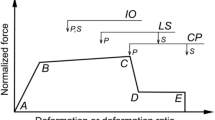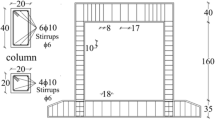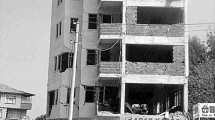Abstract
This paper presents simplified engineering tools for seismic analysis of traditional Dhajji-Dewari structures, a concentrically braced timber frame with masonry infill, within the context of vulnerability assessment of existing stock, strengthening and restoration of historical heritage and feasibility analysis of future construction projects. Similar like structures can be found in various parts of America, Asia, Europe and the Middle-East. The study included tools for the evaluation of lateral force-deformability characteristics of Dhajji walls using non-linear static pushover analysis, simplified models for nonlinear dynamic time history analysis of Dhajji wall structures subjected to ground shaking, and simplified models for seismic performance evaluation of Dhajji wall structures using hand calculations. Three full scale Dhajji walls tested quasi-static-cyclically, with additional 18 tension and bend tests on timber frame connections, at the Earthquake Engineering Center of Peshawar are analyzed to understand the damage mechanism and salient features of the system in resisting lateral load, retrieve lateral force-deformability behavior, hysteresis response and viscous damping (energy dissipation) of Dhajji walls in order to calibrate tools for nonlinear static and dynamic seismic analysis of Dhajji wall structures. Applications are shown on the seismic performance assessment of example structures and design of new construction schemes. The findings from the present research study can provide help on the seismic performance evaluation of similar like concentrically braced timber frame masonry wall structures.
Similar content being viewed by others
References
Ahmad N (2011) Seismic risk assessment and loss estimation of building stock of Pakistan. PhD Thesis, ROSE School-IUSS Pavia, Pavia
Ahmad N, Ali Q, Crowley H, Pinho R (2011) Displacement-based seismic performance evaluation of Dhajji structural systems. In: Proceedings of the Masonry society-11NAMC, Minnesota
Ahmad N, Ali Q, Crowley H, Pinho R (2012) Earthquake loss estimation of structures in Pakistan. In: Proceedings of the 9CUEE & 4ACEE, Tokyo
Ali Q, Schacher T, Ashraf M, Alam B, Naeem A, Ahmad N, Umar M (2012) In-plane behavior of Dhajji-Dewari structural system (wooden braced frame with masonry infill). Earthq Spectra (accepted)
Aktas E, Didem Y, Turer A, Erdil B, Akyuz U, Guchan NS (2010) Testing and seismic capacity evaluation of a typical traditional Ottoman Timber Frame. Adv Mater Res, 133–134 (629–634)
Avrami E (2010) Preserving Haiti’s gingerbread houses: 2010 earthquake mission report. World Monuments Fund, New York
BCP (2007) Building code of Pakistan-Seismic provisions-2007. Ministry of Housing and Works, Islamabad
Buchanan A, Deam B, Fragiacomo M, Pampanin S, Palermo A (2008) Multi-storey prestressed timber buildings in New Zealand. Struct Eng Int 18: 166–173
Bulleit WM, Sandberg LB, Drewek MW, O’Bryant TL (1999) Behavior and modeling of wood-pegged timber frames. J Struct Eng ASCE 125: 3–9
Burnett DT, Clouston P, Damery DT, Fisette P (2003) Structural properties of pegged timber connections as affected by end distance. For Prod J 53: 50–57
Ceccotti A, Faccio P, Nart M, Sandhaas1 C, Simeone P (2006) Seismic behaviour of historic timber-frame buildings in the Italian dolomites. In: International wood committee 15th international symposium, Istanbul and Rize, Turkey
CEN (1994) Eurocode 8, Design provisions for earthquake resistance of structures, part 1–1: general rules–seismic actions and general requirements for structures, prEN 1998-1-1, Comité Européen de Normalisation, Brussels
CEN (2004) Eurocode8: design of structures for earthquake resistance. Part-1: general rules, seismic actions and rules for buildings, EN 1998-1-3, Comité Européen de Normalisation, Brussels
Chopra AK (2003) Dynamics of structures: theory and applications to earthquake engineering, 3rd edn. Prentice-Hall, NJ
Chopra AK, Goel RK (2001) Direct displacement based design: use of inelastic vs. elastic spectra. Earthq Spectra 17: 47–64
CSI: (1999) SAP2000: three dimensional static and dynamic finite element analysis and design of structures. Computers and StructuresInc. (CSI), Berkeley
Der Kiureghian A (2005) First– and second–order reliability methods. In: Nikolaidis E, Ghiocel DM, Singhal S (eds) Engineering design reliability handbook
Doğangün A, Tuluk Ö, Livaoğlu R, Acar R (2006) Traditional wooden buildings and their damages during earthquakes in Turkey. Eng Fail Anal 13: 981–996
Dwairi HM, Kowalsky MJ, Nau JM (2007) Equivalent damping in support of direct displacement-based design. J Earthq Eng 11: 512–530
Elnashai AS, Di-Sarno L (2008) Fundamentals of earthquake engineering. Wiley, West Sussex
ERRA (2006a) Earthquake reconstruction and rehabilitation authority (ERRA), Islamabad, Pakistan. (http://www.erra.pk/default.asp)
ERRA (2006b) Recommendations for ERRA approved Dhajji timber frame house construction. EERA, Islamabad, Pakistan. http://www.erra.pk/Reports/Housing/Dhajji%20Poster/English/DhajjiPoster.pdf
Faccioli E, Villani M (2009) Seismic hazard mapping for Italy in terms of broadband displacement response spectra. Earthq Spectra 25: 515–539
Faccioli E, Paolucci R, Rey J (2004) Displacement spectra for long periods. Earthq Spectra 20: 347–376
Filiatrault A, ASCE M, Fischer D, Folz B, Uang CM (2002) Seismic testing of two-story wood frame house: influence of wall finish materials. J Struct Eng 10
Galasco A, Lagomarsino S, Penna A (2002) TREMURI program: seismic analyses of 3D masonry buildings. University of Genoa, Genoa
Güçhan NS (2007) Observations on earthquake resistance of traditional timber-framed houses in Turkey. Build Environ 42: 840–851
Gülhan D, Güney IÖ (2000) The behaviour of traditional building systems against earthquake and its comparison to reinforced concrete frame systems; experiences of Marmara earthquake damage assessment studies in Kocaeli and Sakarya. In: Proceedings for earthquake-safe: lessons to be learned from traditional construction. Istanbul
Gülkan P, Langenbach R (2004) The earthquake resistance of traditional timber and masonry dwellings in Turkey. In: Proceedings of the 13th world conference on earthquake engineering. Vancouver, Canada
Hancock J, Bommer JJ, Stafford PJ (2008) Numbers of scaled and matched accelerograms required for inelastic dynamic analyses. Earthq Eng Struct Dyn 37: 1585–1607
Jacobsen LS (1960) Damping in composite structure. In: Proceedings of the 2nd world conference on earthquake engineering. Tokyo and Kyoto, Japan
Jain AK (2010) Historical developments in India towards seismic safety and lessons for future. In: Proceedings of the 14th world conference on earthquake engineering. Beijing, China
Jain SK, Nigan NC (2000) Historical developments and current status of earthquake engineering in India. In: Proceedings of the 12th world conference on earthquake engineering. Auckland, New Zealand
Javed M, Naeem A, Magenes G (2008) Performance of masonry structures during earthquake-2005 in Kashmir. Mehran Univ Res J Eng Technol 27:271–282
Kappos AJ, Penelis GG, Drakopoulos CG (2002) Evaluation of simplified models for lateral load analysis of unreinforced masonry buildings. J Struct Eng 128: 890–897
Kouris LAS, Kappos AJ (2012) Detailed and simplified non-linear models for timber-framed masonry structures. J Cult Herit 13: 47–58
Lang AF, Marshall JM (2011) Devil in the details: success and failure of Haiti’s nonengineered structures. Earthq Spectra 27: S345–S372
Langenbach R (2010) Rescuing the baby from the bathwater: traditional masonry as earthquake-resistant construction. In: Proceedings of the international Masonry Society, 8IMC. Dresden, Germany. Keynote Speech
Langenbach R (2008) Resisting earth’s forces: typologies of timber buildings in history. Struct Eng Int 18: 137–140
Langenbach R (2007) From “Opus Craticium” to the “Chicago Frame”: earthquake-resistant traditional construction. Int J Archit Herit 1: 29–59
Magenes G (2006) Masonry building design in seismic areas: recent experiences and prospects from a European standpoint. In: Proceedings of the 1st European conference on earthquake engineering and seismology. Keynote 9, Geneva, Switzerland
Magenes G, Fontana D (1998) Simplified non-linear seismic analysis of masonry buildings. In: Proceedings of the of the British Masonry Society, vol 8, pp 190–195
Magenes G, Calvi GM (1997) In-plane seismic response of brick masonry walls. Earthq Eng Struct Dyn 26: 1091–1112
McKenna F, Fenves GL, Scott MH (2008) Open system for earthquake engineering simulation (OpenSees): version2.1.0. University of California Berkeley, California 2008. (http://opensees.berkeley.edu/)
Menon A, Magenes G (2011) Definition of seismic input for out-of-plane response of masonry walls: I. parametric study. J Earthq Eng 15: 165–194
Mumtaz H, Mughal SH, Stephenson M, Bothara JK (2008) The challenges of reconstruction after the October 2005 Kashmir earthquake. In: Proceedings of the New Zealand Society for Earthquake Engineering. Wairakei, New Zealand
Naseer A, Naeem A, Hussain Z, Ali Q (2010) Observed seismic behavior of buildings in northern Pakistan during the 2005 Kashmir earthquake. Earthq Spectra 26: 425–449
Newcombe MP, Pampanin S, Buchanan A, Palermo A (2008) Section analysis and cyclic behavior of post-tensioned jointed ductile connections for multi-storey timber buildings. J Earthq Eng 11(S1): 83–110
Newmark NM (1959) A method of computation for structural dynamics. ASCE J Eng Mech Div 85: 67–94
Pampanin S (2005) Emerging solutions for high seismic performance of precast/prestressed concrete buildings journal of advanced concrete technology. High Perform Syst 3: 202–223
Pampanin S, Christopoulos C, Priestley MJN (2002) Residual deformations in the performance-based seismic assessment of frame structures, Technical Report. IUSS Press, Pavia
Pennucci D, Sullivan TJ, Calvi GM (2011) Displacement reduction factors for the design of medium and long period structures. J Earthq Eng 15(S1): 1–29
Pinto PE, Giannini R, Franchin P (2004) Seismic reliability analysis of structures. IUSS Press, Pavia
Popovski M, Prion HGL, Karacabeyli E (2002) Seismic performance of connections in heavy timber construction. Can J Civil Eng 29: 389–399
Popovski M, Prion HGL, Karacabeyli E (2003) Shake table tests on single-storey braced timber frames. Can J Civil Eng 30: 1089–1100
Priestley MJN, Calvi GM, Kowalsky MJ (2007) Displacement-based seismic design of structures. IUSS Press, Pavia
Priestley MJN, Sritharan S, Conley JR, Pampanin S (1999) Preliminary results and conclusions from the PRESSS Five-story Precast Concrete Test-Building. PCI J 44: 42–67
Rai DC, Murty CVR (2005) Preliminary report on the 2005 north Kashmir earthquake of October 8, 2005. Technical Report. Indian Institute of Technology, Kanpur
Rossetto T, Peiris N (2009) Observations of damage due to the Kashmir earthquake of October 8, 2005 and study of current seismic provisions for buildings in Pakistan. Bull Earthquake Eng 7: 681–699
Schacher T, Ali Q (2010) Dhajji construction: a guide for technicians and artisans. UN-Habitat, Islamabad
Schacher T, Ali Q (2008) Timber reinforced stone masonry in northern Pakistan in the context of the post earthquake reconstruction efforts. In: Proceedings of the international seminar on seismic risk and rehabilitation. Azores, Portugal
Scott MH, Fenves GL (2010) A Krylov subspace accelerated newton algorithm: application to dynamic progressive collapse simulation of frames. J Struct Eng 136: 473–480
Smith T, Pampanin S, Fragiacomo M, Buchanan A (2008) Design and construction of prestressed timber buildings for seismic areas. NZ Timber Des J 16: 3–10
Spence R (2007) Saving lives in earthquakes: successes and failures in seismic protection since 1960. Bull Earthquake Eng 5: 139–251
Sullivan TJ, Priestley MJN, Calvi GM (2012) A model code for the displacement-based seismic design of structures-DBD12. IUSS Press, Pavia
Tsakanika-Theohari E, Mouzakis H (2010) A post-byzantine mansion in Athens. The restoration project of the timber structural elements. In: Proceedings of the world conference on timber engineering. Trento, Italy
Vamvatsikos D, Cornell C (2002) Incremental dynamic analysis. Earthq Eng Struct Dyn 31: 491–514
Author information
Authors and Affiliations
Corresponding author
Rights and permissions
About this article
Cite this article
Ahmad, N., Ali, Q. & Umar, M. Simplified engineering tools for seismic analysis and design of traditional Dhajji-Dewari structures. Bull Earthquake Eng 10, 1503–1534 (2012). https://doi.org/10.1007/s10518-012-9364-9
Received:
Accepted:
Published:
Issue Date:
DOI: https://doi.org/10.1007/s10518-012-9364-9




